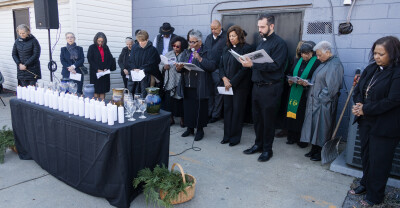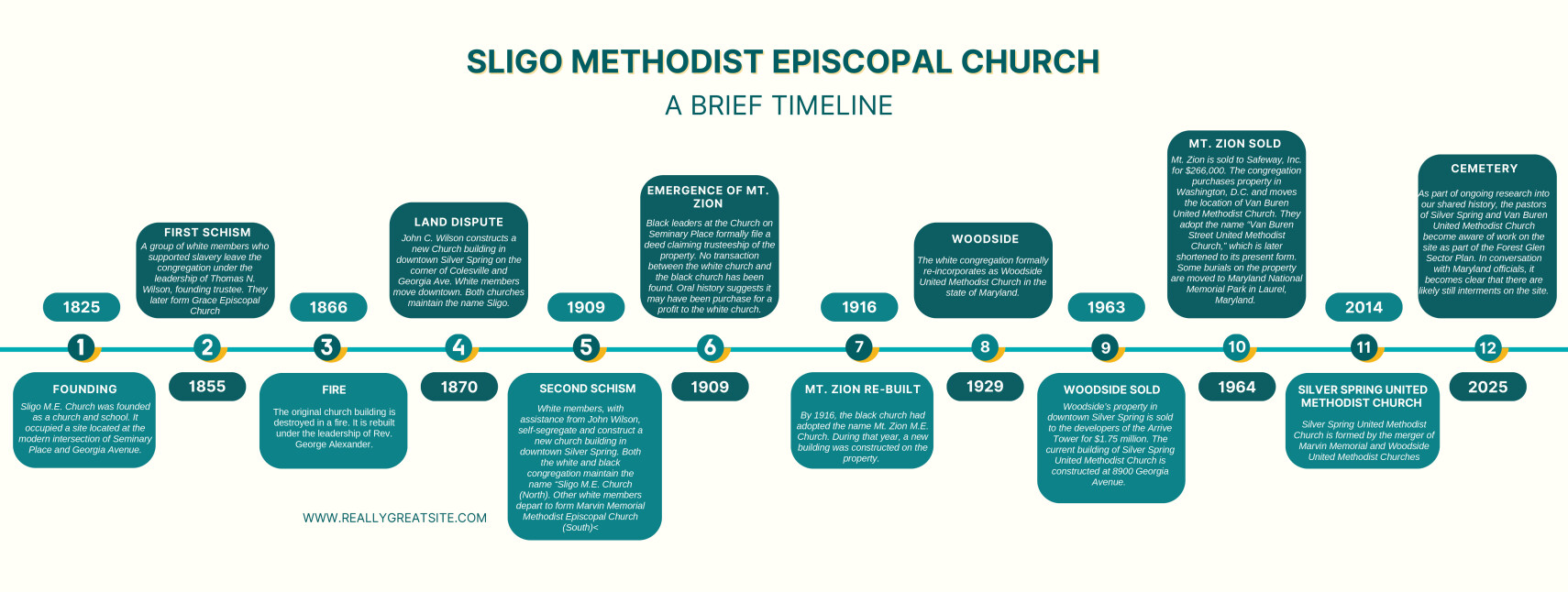“The Stones Will Shout Out”: Remembering Mt. Zion Cemetery in Silver Spring
By Alison Burdett
On the brisk Wednesday morning of November 5, approximately 130 people gathered in a parking lot in Silver Spring, Maryland, that became holy ground again. The Georgia Avenue traffic faded beneath the tolling of a bell and the calling of 38 names, some known, some “only to God.” Each name marked a life once laid to rest at Mt. Zion Cemetery, a burial ground erased by urban renewal.
“This morning,” said Rev. Will Ed Green of Silver Spring United Methodist Church, “the stones of this place no longer allow us to remain silent. They speak from a landscape intended to silence them.”
The site, just in front of the Aldi on Georgia Avenue, was once the resting place for Black residents of Sligo from 1862 to 1963. Although only six burials were officially moved when the property was sold in 1964, church leaders have since identified at least 38 individuals whose graves were never relocated. The hope is that they will be discovered through ground penetrating radar (GPR), happening November 5-7, at the former Montgomery Hills Car Wash parking lot and Aldi parking lot.
 The service, held jointly by Silver Spring United Methodist Church and Van Buren UMC, served both as a prayer and as a step toward reparations. Rev. Green’s words echoed over the pavement, “We condemn and reject the laws of this land which led to the destruction of this community and desecration of these grounds,” he said, inviting those clergy assembled to bless the ground with water as a sign of renewal. “May it wash away the lies of the past. May it mark a new beginning which is more just and righteous.”
The service, held jointly by Silver Spring United Methodist Church and Van Buren UMC, served both as a prayer and as a step toward reparations. Rev. Green’s words echoed over the pavement, “We condemn and reject the laws of this land which led to the destruction of this community and desecration of these grounds,” he said, inviting those clergy assembled to bless the ground with water as a sign of renewal. “May it wash away the lies of the past. May it mark a new beginning which is more just and righteous.”
Among those attending was Bishop LaTrelle Easterling, who described the service as a long-overdue act of dignity. “These were individuals who, even though they were disregarded in life, were created in the image and likeness of God,” she said. “To bring dignity again to their being, and to their families, brings a measure of peace.”
Rev. Green commented on the number of people who attended the service, "I think it’s a testament to the ways that moments like this don’t have to be about division or hate or anger, that they really can be opportunities for us to come together to tell the truth in love in a way that builds and sustains beloved community.”
 Immediately following the vigil was the start of the ground-penetrating radar (GPR) testing, part of Maryland’s Forest Glen Sector Plan to widen the roadway. The state, working with the descendant congregations, hopes to determine the full extent of the burial ground before construction proceeds. “We’re not here to stop progress,” Rev. Green emphasized. “We simply want the story, and the dignity, of those who called Sligo home to be honored.”
Immediately following the vigil was the start of the ground-penetrating radar (GPR) testing, part of Maryland’s Forest Glen Sector Plan to widen the roadway. The state, working with the descendant congregations, hopes to determine the full extent of the burial ground before construction proceeds. “We’re not here to stop progress,” Rev. Green emphasized. “We simply want the story, and the dignity, of those who called Sligo home to be honored.”
That message, he added, extends far beyond Silver Spring. “This is not just about a site,” he said. “It’s about the ways law was used to intentionally erase the stories of Black communities. There can be no healing without confrontation.”
 For many in attendance, the reconsecration brought generations of silence to an end. Paulette Smith Dawes, a descendant of George and Maria Washington, two of the original members of Mt. Zion, spoke with a heart at peace. “To hear that my great-great-grandfather may be here, that his name was found as part of this church, it just makes me feel grateful,” she said. “Pieces of our family story are finally coming together.”
For many in attendance, the reconsecration brought generations of silence to an end. Paulette Smith Dawes, a descendant of George and Maria Washington, two of the original members of Mt. Zion, spoke with a heart at peace. “To hear that my great-great-grandfather may be here, that his name was found as part of this church, it just makes me feel grateful,” she said. “Pieces of our family story are finally coming together.”
Other families echoed her sentiment. Patricia Tyson, who was baptized at Mt. Zion before her family’s move to Washington, said she felt the presence of her ancestors. “They never thought anything about this being a special place dedicated to them,” she said softly. “To know people are still talking and remembering, it means everything.”
 The reconsecration ended not in silence but in song. As clergy sprinkled water over the lot, the crowd lifted their voices in “Lift Every Voice and Sing.” Bells tolled again, and the Rev. Cindy Kent of Van Buren UMC offered a benediction. “We are standing here in a place of reconciliation,” she said. “The history is complicated, but we need to know it so we can be a better today people, and set a better example for those who will be the tomorrow people.”
The reconsecration ended not in silence but in song. As clergy sprinkled water over the lot, the crowd lifted their voices in “Lift Every Voice and Sing.” Bells tolled again, and the Rev. Cindy Kent of Van Buren UMC offered a benediction. “We are standing here in a place of reconciliation,” she said. “The history is complicated, but we need to know it so we can be a better today people, and set a better example for those who will be the tomorrow people.”
Reflecting on the meaning of the day, Rev. Green said the work of remembrance and reconciliation must continue beyond this moment. “We have to be willing to confront the painful parts of our past,” he said, “if we are truly committed to loving boldly, serving joyfully, and leading courageously.”
The results of the radar testing are expected within 60 days, after which descendant families will decide the next steps. “Even that which was intended for evil,” Rev. Green told the crowd, “God can yet purpose for good.”


